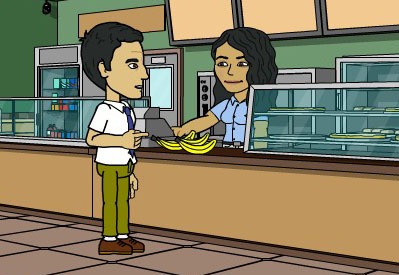Lesson 3
In this lesson you’ll learn:
VOCABULARY AND PHRASES
- numbers
GRAMMAR:
- plural form of nouns
- genitive case after numbers
Numerals
|
1 |
jeden /jedna /jedno |
|
11 |
jedenaście |
|
|
2 |
dwa /dwie |
|
12 |
dwanaście |
|
|
3 |
trzy |
|
13 |
trzynaście |
|
|
4 |
cztery |
|
14 |
czternaście |
|
|
5 |
pięć |
|
15 |
piętnaście |
|
|
6 |
sześć |
|
16 |
szesnaście |
|
|
7 |
siedem |
|
17 |
siedemnaście |
|
|
8 |
osiem |
|
18 |
osiemnaście |
|
|
9 |
dziewięć |
|
19 |
dziewiętnaście |
|
|
10 |
dziesięć |
|
20 |
dwadzieścia |
|
20 |
dwadzieścia |
|
200 |
dwieście |
|
|
30 |
trzydzieści |
|
300 |
trzysta |
|
|
40 |
czterdzieści |
|
400 |
czterysta |
|
|
50 |
pięćdziesiąt |
|
500 |
pięćset |
|
|
60 |
sześćdziesiąt |
600 |
sześćset |
||
|
70 |
siedemdziesiąt |
|
700 |
siedemset |
|
|
80 |
osiemdziesiąt |
|
800 |
osiemset |
|
|
90 |
dziewięćdziesiąt |
900 |
dziewięćset |
||
|
100 |
sto |
1000 |
tysiąc |
Creating compound numerals is rather simple – just combine hundreds, tens and units)
25- dwadzieścia pięć
43- czterdzieści trzy
65- sześćdziesiąt pięć
132- sto trzydzieści dwa
357- trzysta pięćdziesiąt siedem
568 - pięćset sześdziesiąt osiem
1456 - tysiąc czterysta pięćdziesiąt sześć
For numbers higher than 1999, use a unit and plural form of thousand, which is
tysiące
or
tysięcy (for all numbers ending in 2-4)
2000 - dwa tysiące
5000 - pięć tysięcy
73 000 -siedemdziesiąt trzy tysiące
75 000- sidemdziesiąt pięc tysięcy
103 750 -sto trzy tysiące siedemset pięćdziesiąt
Related interactive test: Numerals 1-99.» take the interactive test
Related interactive test: Numerals 100-1 000 000.» take the interactive test
Related interactive test: Numerals - puzzle.» take the interactive test
Related interactive test: Numerals - listening.» take the interactive test
----------------------------------------------------

M: Idę do sklepu. Chcesz coś?
G: Możesz kupić banany?
M: Oczywiście, coś jeszcze?
G: Może jeszcze wodę.
M: Nie ma problemu.

Sprzedawczyni: Proszę!
M: Są banany?
S: Tak! Ile?
M: Proszę trzy.
S: Coś jeszcze?
M: Tak, proszę jeszcze wodę.
S: Proszę bardzo.
M: Po ile są kanapki?
S: Po cztery złote.
M: Proszę dwie.
S: Razem 14 złotych.
|
Idę do sklepu. |
I’m going to the shop. |
|
|
chcieć |
to want |
|
|
Chcesz coś? |
Would you like something? |
|
|
Możesz kupić banany? |
Can you buy bananas? |
|
|
oczywiście |
of course |
|
|
coś jeszcze? |
anything else? |
|
|
może |
perhaps |
|
|
woda |
water |
|
|
Nie ma problemu. |
No problem. |
|
|
sprzedawczyni |
a shop assistant (female) |
|
|
Są banany? |
Do you have bannas? |
|
|
tak |
yes |
|
|
ile |
how many (also: how much) |
|
|
Proszę cztery. |
Four, please. |
|
|
Po ile są … |
How much are … |
|
|
razem |
altogether |
|
Related interactive test: Prices - listening.» take the interactive test
Nouns in plural
In the dialogues you’ve seen three nouns used in plural (the name of Polish currency “złoty” can actually be considered as an adjective [golden].)
|
singular |
plural |
|
banan |
banany |
|
kanapka |
kanapki |
|
złoty |
złote |
Learn more about forming plurals in the article below:
Related interactive test: Nouns in plural.» take the interactive test
Genitive case after numbers [CHALLENGE!]
To form plural forms, you’ll need to master the genitive case. The problem is that Polish uses basic plural forms (in the nominative case) only after numbers 2-4 (or higher numbers ending in units 2-4); for other numbers, the genitive case is used.
Why? It’s actually hard to say, but probably up to a certain point of the language’s evolution it had a counting system up to number 4. When the decimal system appeared, the higher numbers were considered as artificial groupings. Just as you would say a bunch OF roses, Polish uses something like “OF” after five or six.
Moreover, as the higher numbers are treated as groupings, you will use singular verb forms in connection with them.
Tutaj mieszkają 3 osoby.
Tutaj mieszka 5 osób.
If there is a transitive verb before a numeral higher than 4, it is the numeral that determines the case of the following noun, not the transitive verb, so you use genitive.
Ex. Mam pięć książek.
Related interactive test: Nominative and genitive in plural.» take the interactive test
Related interactive test: Genitive case (after packaging units).» take the interactive test
Related interactive test: Revision - lesson 3(a) NUMBERS.» take the interactive test
Related interactive test: Revision - lesson 3(b).» take the interactive test
 LearnPolish
LearnPolish